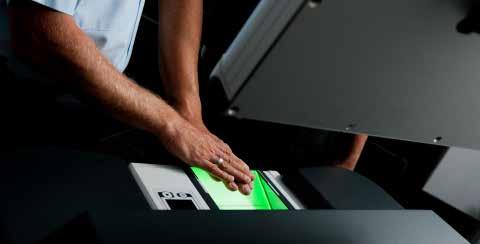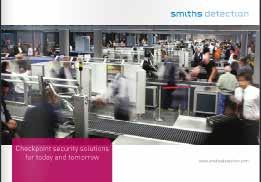
13 minute read
industry news
Vacant workplaces and buildings are places for perpetrators
As the potentially deadly COVID-19 virus continues to spread, many offices, retail operations, manufacturing facilities and other businesses close and send employees home to work. Those empty facilities ‘ contents can become easy targets for criminals.
Advertisement
Most companies are secured by conventional plastic access cards or access control schemes. Yet, by themselves, they may not be enough. Commonly used forms of cards-mag stripe, proximity, even MIFARE or iCLASS-may be cloned by an accomplished hacker within minutes. Which will produce two equivalent cards but the disparity will not be recognized by the device program.
Imagine server rooms, storage of equipment and many other places which are all readily available to unauthorized people. That is why it has become so necessary to provide twofactor authentication using a biometric technology. Cloning fingerprints, facial expressions, and iris patterns is hard,
almost difficult.
But what betters one biometric device than the others? Readers needing fingerprint touch. The COVID-19 virus has been demonstrated to live for as long as three days on stainless steel and plastics. Facial recognition is contactless; but the systems are not the most reliable. And many people wearing protective masks today merely decrease the accuracy.
Recognition of iris is highly precise, able to recognize a person wearing gloves, masks, goggles, glasses and lenses. It’s likewise contactless. There is also no need to reenroll workers into the security program as the iris pattern of a individual is set at birth.
Installing iris recognition readers at building entrances provides a vital second layer of protection at insecure premises as they remain vacant during this global health crisis.
By Mohammed Murad is vice president global sales and business development, Iris ID
New South Wales Police Force and IDEMIA Extend Partnership to Strengthen Criminal Identification System
IDEMIA has renewed its partnership with the New South Wales Police Force, the largest police force in Australia. Under the six-year contract, IDEMIA will support and maintain the LiveScan solution, a powerful biometric identification solution to process and book criminals’ biometric data in 142 police stations across New South Wales.
IDEMIA’s LiveScan technology provides law enforcement jurisdictions with a flexible workflowbased application to capture criminals’ biometric information and demographics. LiveScan ensures that the biometric solution can be deployed across the state efficiently while meeting the highest quality and safety requirements.

The New South Wales Police Force is serving more than 7.5 million people over an area of 800,000 sq. km. IDEMIA is the leader on the Australian market for biometric enrolment and authentication as LiveScan is being used across the states of New South Wales, Queensland, Victoria and the Northern Territory. a long-term partnership that we have had with the New South Wales Police Force for over two decades”, said Tim Ferris, Asia Pacific President and Senior Vice President for Public Security and Identity at IDEMIA. “This collaboration proves IDEMIA’s capacity to provide critical support and maintenance when it comes to integrating multiple biometrics technology to increase national security and support efficient police services. It is a great honour to be supporting the biggest police organization in Australia.”
Canadian tech company has announced a product that allows governments to analyse the patterns and movement in public spaces to support emergency response strategies and social distancing programs
InnerSpace has announced its product capabilities to support all levels of government to analyse the patterns and movement in public spaces using existing WiFi networks. The platform is ideally suited to understand the movement of people inside public spaces and can support emergency response strategies, social distancing programs, and help Smart Cities implement effective security and public safety measures.
“In response to the global COVID-19 pandemic, we have accelerated the delivery of our public safety solution inFORCE,” said James Wu, CEO, InnerSpace. “Our platform processes RSSI data in real-time and returns the industry’s most accurate location data available today. By using public WiFi access points, municipalities have a way to quickly roll out new solutions at citywide scale.”
InnerSpace inFORCE, was selected in a competitive process by the Department of Homeland Security, for its ability to use WiFi to locate citizens and track emergency responders in an active shooter scenario.

The same platform can be used in a wide variety of emergency situations such as the current COVID-19 pandemic. In addition to the company’s tracking capabilities, it’s analytics dashboard gives public safety offices an unprecedented view into how people leverage public spaces.
“In times of emergency, it is reasonable to prioritize safety and public health to minimize the loss of human life,” said Cerys Goodall, President & COO, InnerSpace. “By providing municipalities with a system that can deliver line-of-sight into how people move in public spaces, we can inform response strategies, improve rescue efforts, and create an infrastructure to support better outcomes.”
InnerSpace inFORCE ingests RSSI data and returns accurate anonymous indoor locations. The information can be connected directly into emergency response communications systems, building management and security systems, or analysed by InnerSpace to identify critical patterns and trends in people’s movements.
3DX -Ray Secures New Contract for Asian Customer
3DX-Ray have announced a sale of its ThreatScan®- LS3 lightweight, x-ray scanner system to an undisclosed government agency in Asia.
After initial operator training provided by 3DX-Ray, the system will be deployed in co-operation with the United Nations on mine and EOD clearance peace keeping missions in the Middle East and Africa.
ThreatScan®- LS3 is a compact, yet powerful x-ray scanning system that can penetrate 34mm steel at 120kV as standard. The 305mm x 256mm imaging

area enables typical bags and packages to be scanned in one scan. The complete system fits securely into a backpack, ideal for operations in remote locations.
Designed for rapid deployment and ease of use, ThreatScan® systems operate with the intuitive and userfriendly ThreatSpect software to produce high quality, submillimetre resolution images.
The ThreatScan®- LS3 is designed so that the operative can achieve accurate highquality images quickly and efficiently.
Protecting Prisoners, Prison Staff and Visitors from CO VID -19
The world is currently facing an unprecedented challenge in dealing with the coronavirus (COVID-19) pandemic. The World Health Organization’s prevention advice is simple; wash your hands, cough into your elbow, avoid touching your face, distance yourself at least one metre from another person and if you feel unwell, stay at home. Above all, keep away from other people, or what is now termed ‘social distancing’.
For the general public, in theory, these measures should be relatively easy to adhere to, although they are proving challenging enough, ‘social distancing’ in a prison environment is almost impossible, leaving prison staff, prisoners and visitors vulnerable.
Prison Reform International (PRI) in their recent briefing note, said “The difficulties in containing a large outbreak in detention facilities are clear. People in prison and the personnel who work with them are in close proximity and in many cases in overcrowded, cramped conditions with little fresh air. People in detention also have common demographic characteristics with generally poorer health than the rest of the population, often with underlying health conditions. Hygiene standards are often below that found in the community, and sometimes security or infrastructural factors reduce opportunities to wash hands or access to hand sanitizer – the key prevention measures recommended by the World Health Organization.”
If luxurious cruise ships were described during the initial outbreak of COVID-19, as a “Floating Petri Dishes”, then it is not difficult to imagine the challenges facing prisons.
The numbers of infected prisoners around the world are increasing daily - A scary proposition for authorities to handle.
Most Countries have issued their own standards for their prisons.
The Government of Iran temporarily released 70,000 prisons. Each prisoner had to test negative for COVID-19 and post bail before being released.
The automatic first step taken by prison/detention authorities to prevent an outbreak of a disease is to limit contact with the outside world; generally, to stop visitations.

erupted in 27 prisons when visiting rights were stopped, killing and injuring many prisoners and staff.
In Colombia, riots broke out across 13 prisons, killing at least 23 prisoners and staff and injuring many more.
These incidents and others around the world were triggered by fear of the unknown and the perceived helplessness of the prisoners.
The World Health Organizations interim guidance on how to deal with COVID-19 in Prisons,
“Preparedness, prevention and control of COVID-19 in prisons and other places of detention” - lists advice concerning the risk of; communicating the disease, personal protection measures, use of masks, environmental measures, physical distancing measures, and staff returning to work. In all instances, the necessity of being closer than one meter from a prisoner, i.e. arrest, restraint or interviewing, the minimum staff should wear are disposable gloves, medical mask, long-sleeved gown, and eye protection, i.e. face shield or goggles.
During this time of crisis the safety of the prisons is paramount and the typical day to day running of the prison needs to continue unhindered, and this includes checking inmates, staff and visitors for any contraband; be that drugs, weapons, cell phones, or any other illegal items.
One of the main benefits of the Soter RS scanner is its ability to scan a person, internally and externally, remotely, even from another room, thereby alleviating the need for close contact, protecting operators, prisoners and visitors alike.
The Soter RS is the worlds most advanced security X-ray system. It is a person X-ray system which combines ultralow radiation with maximum visibility, revealing everything hidden inside human cavities or inside the human body.
It is already used successfully in many prisons worldwide for scanning visitors, inmates, and prison staff.
The Soter RS body scanner can detect any contraband. Indeed, to date, it has identified; drugs/narcotics, weapons, cell phones, plastic items, metals, cash, gemstones and other contraband. If it is hidden, the Soter RS can detect it; whether it is on, or in, the body being scanned.
Integrated counter UAV solution led by FREQUENTIS and HENSOLDT
Frequentis and HENSOLDT sign Memorandum of Understanding (MoU) to intensify collaboration on integrated counter drone solutions for airports
Frequentis, the leading Air Traffic Management (ATM) solution provider, and defence and security sensor specialist HENSOLDT are combing strengths to support the creation of next generation integrated counter unmanned aerial vehicle (UAV) solutions. Both companies are already combining their respective strengths and competences on the FALKE research project, which aims to develop the blueprint solution for the airport environment.
The formation of this MoU further reinforces our intention to create effective solutions to differentiate cooperative and non-cooperative flying objects, ensure shared situational awareness across all organisations

and interoperability with existing airport surveillance infrastructures and available UAV traffic management (UTM) systems. We are pleased to be working on this common goal with HENSOLDT, combining our strengths.” says Günter Graf, Frequentis Head of Business Development.
The Frequentis Group is providing mature components in the areas of UTM/ATM/drone detection, data fusion and exchange (MosaiX SWIM), shared situational awareness and ATM-grade surveillance data automation (SDDSNG, MSDF, PRISMA), cross-agency incident management (ICM), as well as operational requirement analysis (Control Room Consulting). HENSOLDT will provide detection, identification and mitigation modules from their own Xpeller CUAV system.
“Together with Frequentis, we will create a modular counter-UAV system optimised for the specific needs of airports”, added Markus Wolf, Head of Sales and Business Development at HENSOLDT Ventures. “Xpeller demonstrates HENSOLDT’s innovative capabilities, answering our customer’s needs to detect and act against unmanned threats. Due to its versatility, Xpeller is able to offer maximum protection under a variety of conditions and ranges. While available as a fully functional standalone system, its modular approach enables us to easily join forces with partners like Frequentis.”
Both companies already work together on the FALKE project, developing the ability to intercept small UAV that enter restricted airspaces at airports. The integrated solution will enable airports to deal with incidents, like those that took place at British airport Gatwick and German airport Frankfurt, swiftly and effectively. Hamburg Airport will be the model for the resulting blue-print solution, with the partners demonstrating a technical and organisational concept to defend against illegally operating drones.
Herta launches a new technology that allows facial identification even with a mask
Herta is launching this week a new version of its facial recognition algorithms that can correctly identify people who wear facial masks. The company had been working on the issue of partial occlusions for some time and, following the worldwide outbreak of coronavirus (CoVid19), development has been accelerated to launch a version of the software that helps provide an accurate identification under these conditions.
Based on Deep Learning technology, Herta’s algorithms provide very high identification rates, especially in identity verification tasks and their reliability is very high, even when people hide a large part of their face. It is important to remember that the most differential part of the human face is in the eye area.
The launch of this software is key for the identification in automatic passenger control systems with documentation, such as border control with the passport. This way it will not be necessary for the person to remove the mask, avoiding possible contagion or long waiting times. Its application, in general, extends to any type of access control or identity verification system.
Herta expects that the impact of this new technology in the market will be very important worldwide and that it will be used massively in environments such as transportation, health, government, events, sports stadiums or in the gaming sector.

Smiths Detection
Clantect Ltd Institute of Sound and Vibration Research Southampton, SO17 1BJ, United Kingdom Phone: +44 (0) 23 8055 0883 Email: info@clantect.com

Hidden human presence detected by vibration
www.clantect.com
Smiths Detection


advantages World Security Report is a bi-monthly electronic, fully accessible e-news service distributed to over 130,000 organisations globally. It tracks the full range of problems and threats faced by today’s governments, security and armed forces and civilian services and looks at how they are dealing with them. It aims to be a prime source of online information and analysis on security, counterterrorism, international affairs and defence.
Border Security Report

Border Security Report is the bimonthly border management industry magazine delivering agency and industry news and developments, as well as more in-depth features and analysis to over 20,000 border agencies, agencies at the borders and industry professionals, policymakers and practitioners, worldwide.
Smiths Detection


advantages

June 2020 2-4 InfoSecurity Europe London, UK
2-4 National Cyber Summit Huntsville, AL, USA
29 June-2 July National Homeland Security Conference Chicago, IL, USA
July 2020 6-8 SECON 2020 Seoul, Korea
September 2020 2-3 The 15th International Conference on Critical Information Infrastructures Security 2020 Bristol, UK
8-10 IFSEC London, UK
22-23 The Security Event Birmingham, UK
22-25 Security Essen 2020 Essen, Germany
27 Sept - 2 Oct GITEX Global Dubai, UAE To have your event listed please email details to the editor tony.kingham@knmmedia.com

October 2020 6-8 Critical Infrastructure Protection & Resilience Europe Bucharest, Romania www.cipre-expo.com
27-29 Critical Infrastructure Protection & Resilience North America New Orleans, LA, USA www.ciprna-expo.com
November 2020 24-26 World Border Security Congress Athens, Greece www.world-border-congress.com
Paul Gloc UK & ROW E: paulg@torchmarketing.co.uk T: +44 (0) 7786 270 820 Sam Most Mainland Europe &Turkey E: samm@torchmarketing.co.uk T: +44 (0) 208 123 7909
ADVERTISING SALES
Paul McPherson Americas E: paulm@torchmarketing.us T: +1-240-463-1700









